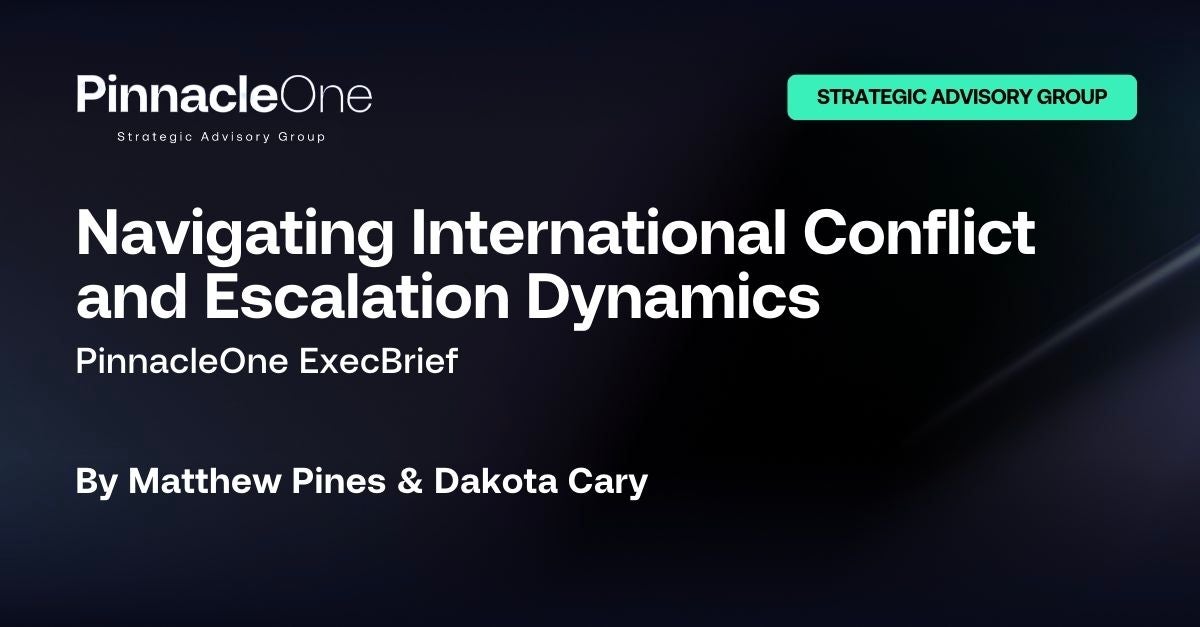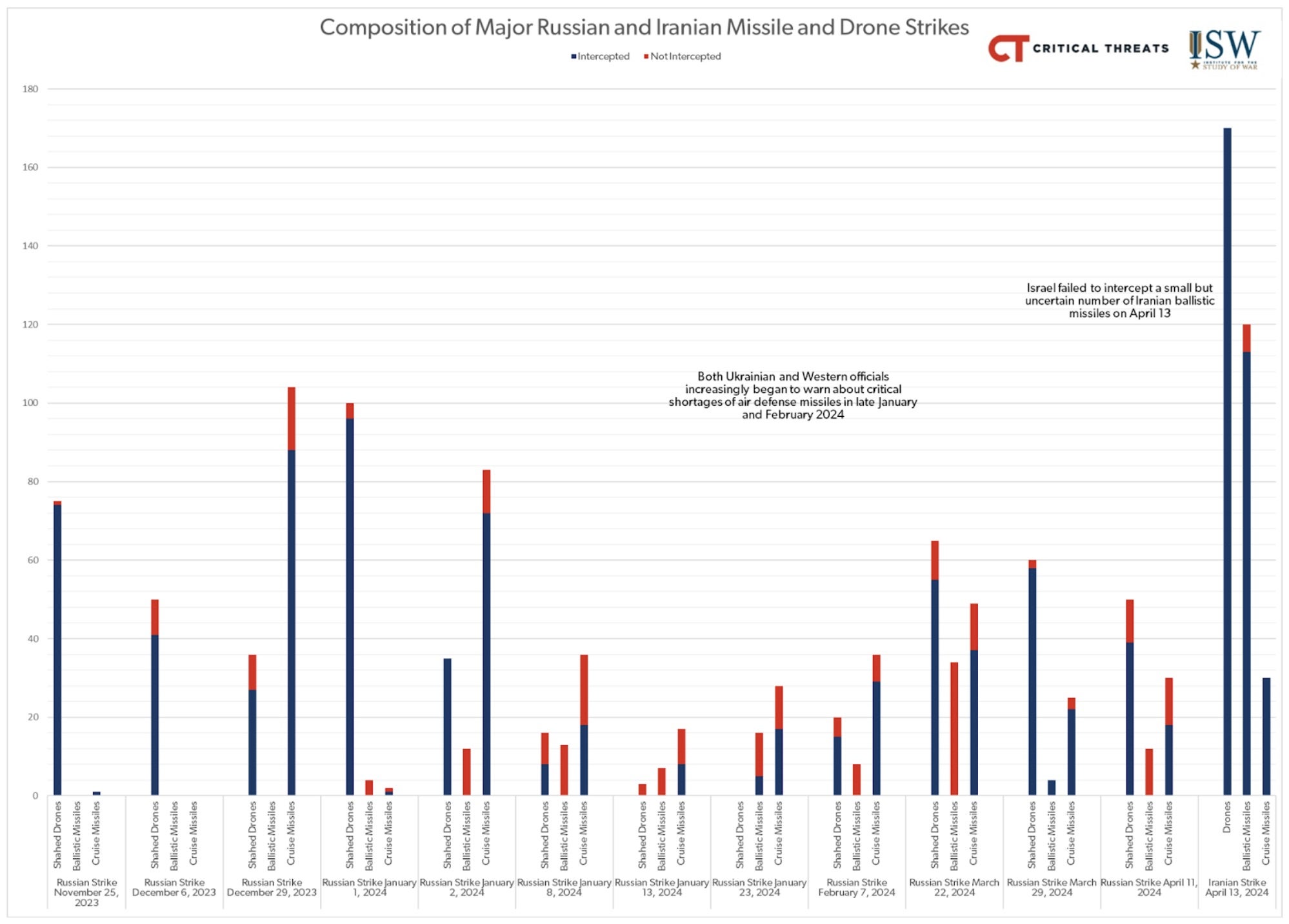Last week, PinnacleOne detailed how firms can navigate the era of AI in cybersecurity and emerging tools to keep pace with advancing threats.
This week, we focus on recent escalation dynamics in the ongoing conflict in the Middle East.
Please subscribe to read future issues — and forward this newsletter to interested colleagues.
Contact us directly with any comments or questions: [email protected]

Insight Focus | Navigating International Conflict and Escalation Dynamics
Summary of Recent Events
Conflict between Israel and Iran simmered for decades before the most recent spike in tensions. The proximate cause for Iran’s assault on Israel this weekend was the result of that country violating well-established norms. Israel bombed an Iranian diplomatic facility adjacent to the main embassy in Syria killing senior Iranian generals. Embassies and their compounds are considered the sovereign land of the country that they represent – in the U.S., law enforcement agencies (like local police) are prohibited from stepping foot within their walls.
Israel’s decision to strike (without prior notice to the U.S.) Iran’s diplomatic facilities in Syria to kill multiple important Iranian military officers crossed that established red line. In response, Iran crossed a line in its relationship with Israel not seen in the last four decades. Missiles and swarms of drones from Iraq, Yemen, Syria, and Iran attacked Israel over the weekend.
The Iranian attack echoes the combined drone, cruise missile, and ballistic missile barrages that Russia uses against Ukraine. The attack even used the same Iranian drones and missiles. An Israeli military spokesman reported that the weekend attack involved more than 170 drones, 30 cruise missiles, and at least 110 ballistic missiles.
However, U.S. officials reported that about half of these ballistic missiles were successfully intercepted (by combined U.S., Israeli, French, British, and even Jordanian systems), and most of the remaining failed to launch or crashed – only a handful reached their targets, causing mostly cosmetic damage to Israeli military bases. This failure may be attributed to a combination of joint air defense systems, which were prepositioned in theater given strong intelligence on the telegraphed Iranian attack.

While a bit of a sideshow, the night of the attack an Iranian affiliated hacking group known as the “CyberAv3ngers” claimed to have disrupted power infrastructure in Tel Aviv. While this was quickly disputed and no evidence of such a disruption materialized, a number of high profile accounts on X amplified the claims, which served to inject uncertainty into the already unsettled information environment.
It should be noted that the U.S. and Israeli governments last year attributed to the IRGC-affiliated CyberAv3ngers persona compromises of Unitronics Vision Series programmable logic controls used in water and wastewater and other industries. While no critical infrastructure was compromised in this weekend’s attack, that shouldn’t induce false confidence that Iranian threat actors lack the intent or capability to do so in the future.
U.S. Urges Restraint
The U.S. is reportedly urging Israel to not respond in-kind and has stated that the US military would not support offensive operations against Iranian territory. Analysts point to the defensibility, and frankly – widely telegraphed response that Iran’s assault constituted – as reason to not escalate further. Iran’s attacks were aimed at Israeli government facilities, overnight and on a weekend, to minimize the potential for significant casualties. Multiple U.S. and British assets engaged incoming Iranian missiles and drones, alongside Israeli defensive equipment. On the whole, Iran’s actions could have been more damaging and more deadly. After concluding their attacks, Iran’s mission to the United Nations stated that the matter had been resolved.
Domestic Politics and Escalation Pathways
Unfortunately, domestic politics in Israel offer potential incentives for escalation. The current Prime Minister Benjamin Netanyahu is unpopular and, before the Hamas attacks that led to the current conflict, was facing mass protests, government resignations, and opposition by other political parties. Owing to ongoing legal issues and based on his past strategies to benefit politically from conflict with Hamas, the current PM may decide that escalating further with Iran is likely to extend his time in power. Opposition politicians are calling for early elections in the fall of this year as the governing coalition is falling apart.
Netanyahu has strong incentives to hold onto power as long as possible, however. He is the defendant in an ongoing, long-delayed, and widespread corruption case. The current conflict has slowed down the prosecution. Netanyahu hopes that he cannot be convicted or sentenced while he is still in office. Extending the war and escalating with Iran into protracted conflict may be in his political interest. However, as the Israeli War Cabinet meets to deliberate on a response, Netanyahu is now facing intense pressure by G7 leaders to refrain or tightly calibrate any reaction, warning publicly that it could provoke an “uncontrollable regional escalation” and likely privately threatening to withhold financial and political support.
Security Posture Recommendations
There are two key scenarios enterprises need to consider: 1) de-escalation to status quo ante and 2) tit-for-tat escalation.
In the first scenario, executives should maintain a heightened state of alert, with a tight loop between risk professionals and organization leaders in the region. In particular, executives should know that staff in Israel are well-acquainted with the realities of war. Many participated in mandatory military service in their youth and some may have been recently deployed for operations in Gaza. As a result, local staff are best equipped to determine their own safety protocols.
- During the coming weeks, the company should exercise work from home flexibility as requested by employees.
- Non-Israeli citizens in the country should be afforded the opportunity to leave if they have not already been offered such accommodations.
- The company should closely monitor Israel’s announcements and changes in diplomatic security posture.
In the second scenario, the prospects for a more intense and destructive regional conflict (e.g., involving direct and large-scale Hezbollah-IDF engagements) become a primary concern. To prepare for this, executives with staff and/or business interests in the region should:
- Expect significant disruptions to their workforce (e.g., call-up, family support, loss of life) and in-country operations (e.g., cascading impacts from attacks on Israeli infrastructure).
- Re-examine business continuity plans and crisis response playbooks.
- Prepare for large commercial spillovers to regional trade and energy markets.
Our current assessment is that the former scenario is more likely than the latter, but prudent executives should ask their teams: What is the plan if the situation deteriorates?


